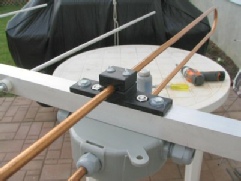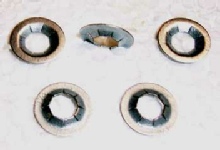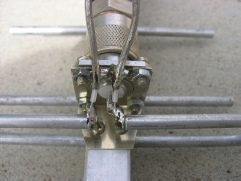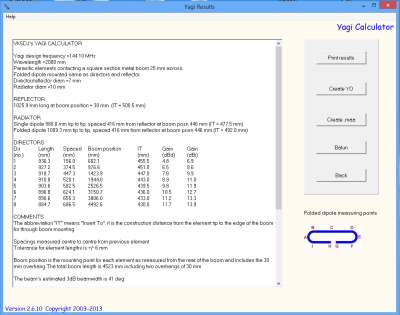

J.F.Drew © 2000-2017






Mobile menus
VK5DJ
In V3.0.1 there have been minor fixes to improve general operation but yagi results are unchanged. File management has received some major work so if you want to maintain old yagi designs you should be aware that these will not work in this version. Although YO files are still produced, Yagi Optimiser is no longer supported by the author. I’ve left this facility in but recommend MMANA-gal to users. Features of this free but copyrighted program include: calculation of the element length and element spacings of a yagi for a particular frequency, different size materials for boom and elements are catered for as are different methods of mounting, dimensions of baluns are calculated, there is provision for entering the dimensions of an existing DL6WU antenna for optimisation through an external program or to gather information on its gain, beamwidth etc. A handy SWR calculator and feedline loss calculator are included as part of the package. Stacking information is also provided as are estimates of gain. A Helpfile is included that covers many aspects of yagi design as well as helping with the operation of the program. A major change is that the program will now work for users in Regions where the comma is used as a decimal separator. The program checks your region and adjusts accordingly but stores MMANA and YO files with dot separators as this is required by those programs.
Before installing this update save your old directories - perhaps change the directory name of your old installation so that you can still run the old version. Download the new version here. Your old data can’t be inputted.
Yagi Calculator by John Drew
DL6WU style yagis for VHF/UHF (updated 20 July 2023)
Yagi Calculator is a Windows program that also runs well on Linux, Ubuntu 8.10 under Wine, to produce dimensions for a DL6WU style long Yagi antenna. Long yagis are commonly used from the 144MHz amateur band to the 2.4GHz band. The DL6WU yagi is highly regarded as being easy to build with repeatable results, broad bandwidth and a useful pattern.
The program on this site was developed in the early 90s as a DOS program. Time moved on and so did operating systems, so the 2003 version was an opportunity to convert to a Windows environment and update the information and modify some of the algorithms. Latest Version is 3.0.1 and introduces auto Region adjustments. I’ve also re-arranged some pages and menus. There are important changes in directories with a different system in place to save your files. Unfortunately this means some incompatibility if you want to rescue old designs. Sometimes progress has a down side.
The old output screen appears to the right.



Acknowledgements
Yagi Calculator is a program to assist with the design of long yagi antennas. It uses the graphs and principles developed by DL6WU and printed originally in the German Radio Magazine VHF Communications (March 1982). The article was titled Extremely Long Yagi Antennas. For best front to back ratio it is recommended that a yagi be constructed with one of the following numbers of elements - 10,14,19,24. Yagi builders are reminded that DL6WU designs are primarily for long yagis. A boom length of 2 wavelengths (or 10 elements) would be a minimum sized antenna. On the other hand, yagis with as few as 8 elements have used the design and worked very well.
The work of David VK3AUU (AR Feb 1988) in developing some equations to fit DL6WU's graphs was very valuable. The reflector calculations are based on a Basic program written by KY4Z and W6NBI and with suggestions by DL6WU. The ARRL Antenna Handbook provided information, as did various sources on the Internet. K5OE's site at http://members.aol.com/K5OE is a particularly useful one.
The author acknowledges the 1998 ARRL Handbook for information on coaxial cable impedance, dielectric and velocity factor.
I acknowledge Kevin Schmidt W9CF (http://fermi.la.asu.edu/w9cf/) for the correction factor for square section rod of 1.18 * cross section of round tube and also for the formula to find the equivalent round cross section for both square and flat element materials (Version 2.5.0)
dself = w[0.5 + 0.9t/w - 0.22(t/w)2] where w is width of material and t is thickness.
The formula source for the impedance calculations is from "Round and Square Section Parallel Transmission Lines Theory, Practice and Applications" by Roger Harrison and Andy Sayers VK2AES, GippsTech Conference 2009, Churchhill, Victoria, Australia.
Square section: Zo=0.45 + 344[s/(s+d)] - 345[s/(s+D)]^2 + 411[s/(s+D)]^3 where s is face-to-face spacing, D=width of square-section line.
Circular section line: Zo=972(s/d) - 481(s/D)^2 + 86(s/D)^3-547 where s is centre-to-centre spacing, D=diameter of circular-section line.
Links
Some valuable comments on scaling and boom diameters from W4RNL
Considerations on the effects of boom diameter by Lief Asbrink, SM5BSZ
Construction of a DL6WU yagi using a folded dipole by Jim W6PQL
Experiments on an antenna range by Jim W6PQL
Various antenna applets and particularly the correction factor for square section versus round rods by Kevin Schmidt.
Some antenna range results by the US National Bureau of Standards
Mounting method used by Steve VA3FM
Balun construction by Colin VK5DK
Spring washers used by Steve VA3FM to fasten his elements


Using Yagi Calculator on a Mac
I am not able to check operation with an Apple Computer but Yagi Calculator will not be able to read the Region data. I can’t help with this problem unfortunately.
Linux
In the downloads page you’ll find a short form of the Yagi Calculator. This was developed by Jack Dodds VE3UKD from short form code provided by me. This short form is provided with the source code on https://gitlab.com/JackDca/yagicalclx
To run the code just download it into any directory and run it from there. It does not need installation.

| Repeater features |
| Solar version |
| 1750Hz decoder |
| Record and playback |
| Voice interface |
| Micor solution |
| Yagi Calculator |
| RD Contest logger |
| Moon Tracking |
| Orbitron interface |
| PRFCalc |
| TAIT programming |
| Proton Development Suite |
| Old crystals for radios |
| Compound interest |
| Yagi photos |
| Bird proofing |
| Bender |
| VK5DJ downloads |
| VK3UM downloads |
| Site map |